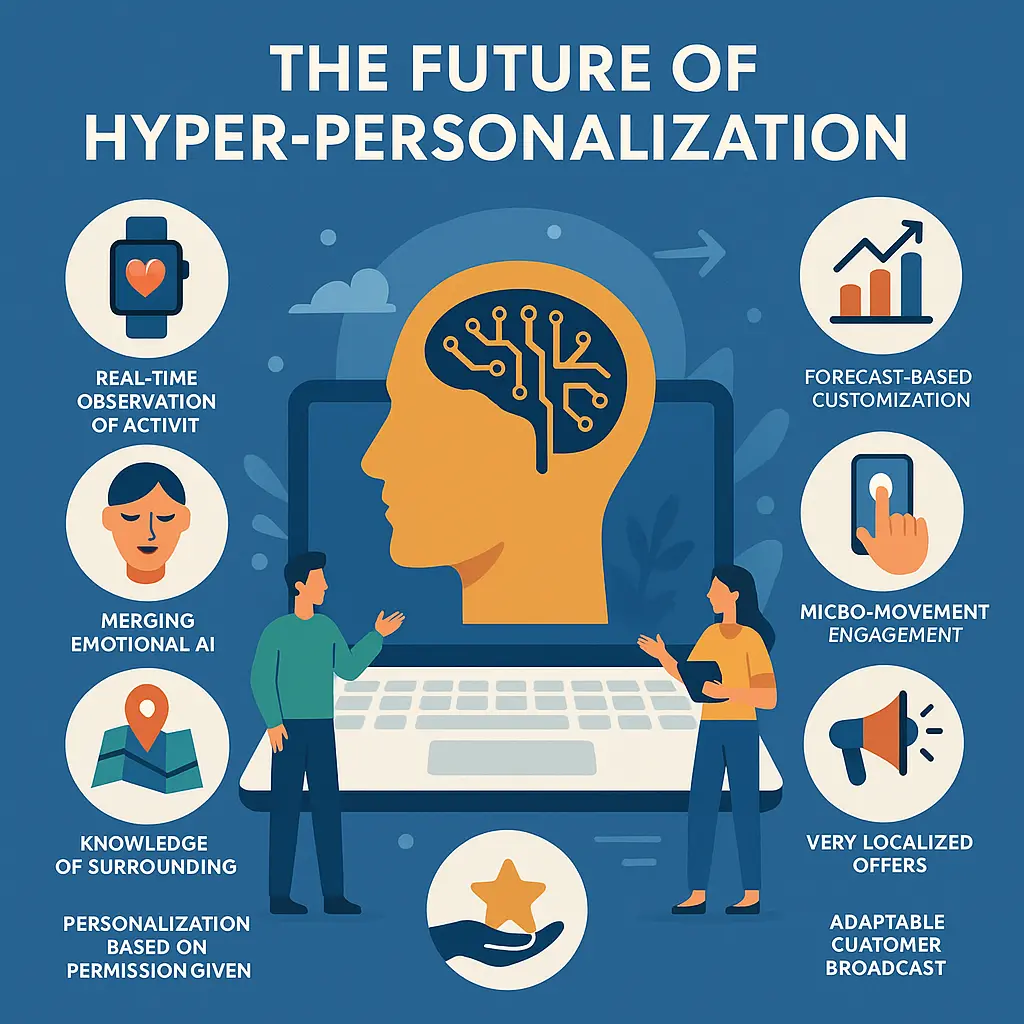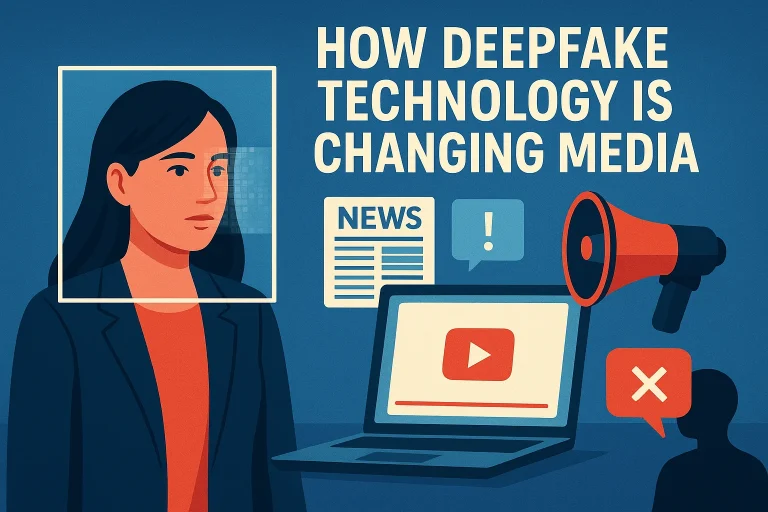
Hyper-Personalization Business Model
Hyper-personalization business model beyond 2025 will become the standard of interaction with consumers. Rapid transformation is required by businesses to provide the very focused experiences consumers seek. Corporate sustainability in 2025 will need hyper-personalisation; it cannot be avoided. Every interaction should seem tailored specifically for each client rather than just a particular few.
The Transformation of Hyper-Personalization
Early on, personalization was mostly based on basic behavioral patterns and demographic information. Based on metrics like geography, gender, age, or previous transactions, businesses broke down their customers into major categories. The topography has changed quite dramatically by 2025. Rather than just past information, companies now combine advanced artificial intelligence and predictive analytics with real-time data feeds.
The hyper-personalization business model of today calls for a deeper, flexible understanding of the circumstances, emotions, and changing needs of every customer. Knowing what a customer bought last month doesn’t cut it anymore; businesses also have to forecast their next wants. Previously unknown extents of proactive engagement will result from artificial intelligence models that can now forecast consumer preferences before people even notice they exist.
A vast and interconnected habitat is propelling this adaptation. Wearable technology, Internet of Things gadgets, and smart settings constantly generate data on people’s activities, tastes, moods, and health, thereby offering real-time insights. These inputs allow organisations to fast alter their offerings and deliver experiences that feel very personal. Whereas others run the risk of falling behind in a market increasingly focused on its customers’ needs, companies excel at real-time, emotionally wise personalization will become leaders in this ecosystem.
Core Aspects of the 2025 Hyper-Personalization Model
1. Real Time Observation of Activity
The new standard is real-time adaptive tracking; passive data collection is archaic.
2. Merging emotional artificial intelligence
Businesses quickly alter their responses to suit their consumers’ mood based on AI that identifies emotions.
3. Knowledge of surrounding.
Offers vary dynamically based on the customer’s location, activity, and time of day.
4. Forecast-based customization
Anticipating needs allows predictive analytics to present to customers even before they start a search.
5. Personalization based on permission given
Using personal information ethically and openly helps one to develop trust.
6. Micro-movement engagement
Companies seize opportunities when consumers are most prone to interact or buy.
7. very localised offers
Geofencing and hyper-local marketing ensure that experiences are personalized to the exact site of the consumer.
8. Adaptable customers broadcast
Each alteration in a customer’s preferences or every fresh encounter will dynamically change the customer journey.
Hyper-Personalization Success New Business Plan
1. Data fusion platforms
Combining information from multiple channels into a unified, intelligent, adaptable system is absolutely vital.
2. DNA Mapping of Consumers
Creating a "DNA map" of every consumer’s tendencies, daily routines, and stressors.
3. Sentiment-responsive content
Changes message, style, and content to match the emotional state of the consumer.
4. Artificial Intelligence Concierge Services
Via tailored AI conciers, one has instant access to specially picked goods, offers, and solutions.
5. Encouragement of Micro-Communities
Brands generate personal experiences and specialized interests to form very specific micro-communities.
6. Personalization-as-a-Service (PaaS)
Providing smaller companies PaaS options with hyper-personality engines.
7. Real-time product personalization
Real-time feedback loops enable consumers to customise and co-create products instantaneously.
8. Customization Depends on Intended Use
arranging customization approaches around the environmental, cultural, and personal values of customers.
Special trends influencing hyper-personalization in 2025
- Well-being Forecasting
Brands forwardly suggest physical, dietary, and health-related activities using biometric data. - Cognizance personalization
AI applications change messages to meet the learning and cognitive needs of the recipient. - Augmented Reality customisation
With AR technology, consumers have access to virtual try-ons and personalized product images in their own environments. - Digital twins personal contact
making digital duplicates of customers to imitate and personalize their internet interactions. - AI generated hyperlocal influencers
Brands create AI influencers specially for certain consumers and regional groups. - Personalization of the Senses
According to customers&’ tastes, smell, touch, and sound, businesses customize experiences. - Payment Choices With Emotional Intelligence
Checkout possibilities differ on a customer’s impulsiveness or security level. - Avatars Object Oriented
Digital personalities representing consumer objectives enable brands to interact with customers.
Business models designed for hyper-personalization.
- Models for Subscription Customization That Need to Be addressed
Consumers subscribe to services that are continuously evolving to meet their changing needs and tastes. - Programs for Predictive Loyalty Discovery
Before consumer dissatisfaction spreads, flexible loyalty programs offer custom incentives. - Emotional-driven pricing models
In reaction to the customer’s need and emotional state, real time pricing changes are carried out. - The Market Reflects
Marketplaces mirror those of their consumers in every interaction point from values, choices, and lifestyle. - Context-as-a-service models
providing companies in need of fast, extremely tailored engagements access to context-awareness tools. - Personalized models for micro-stock levels
maintaining little, fast moving stock that suits local customers. - crowd sourced personalization models
giving consumers brand direction as well as real-time artificial intelligence support allows them to work together on personalized product development. - AI-Guided Value Chain
Redesign AI instantly restructures supply chains to meet the needs of customized products.
Risks of super-personalization
- Much too much privacy
Businesses constantly gathering information runs the risk of consumer burnout and legal enforcement. - compartments of data
Fragmented personalization information leads to erratic consumer interactions and inconsistencies. - Complicated ethical issues
Consumer trust in a brand might never be fully destroyed by unethical use of emotional data. - More automation than is needed
Over-automation runs the risk of making customization seem robotic and impersonal. - Tired of personalization
Customers could feel paralyzed from too much customizing. - Legal modifications
Rising restrictions from artificial intelligence and new data laws including GDPR 2.0 might limit hyper-personalization. - Infrastructure costs
Real-time personalization systems need much investment in AI and data infrastructure. - Risks of bias as well as inaccuracy
Poor data preparation bias can discourage rather than help to develop relationships with consumers.
Victory Strategy for Hyper-Personality in 2025
- Always Attendant for
Always monitor consumer behavior closely but without being controlling or intrusive.
- AI which is explicable for
Consumers need to realize their data drives customized experiences.
- Real-time testing enables
You to constantly A/B test custom components to refine and adapt. - Customer-First Data Philosophy
Employ methods of zero-party data whereby customers freely share their preferences.
- For more customization
Design contacts that cover smell, vision, sound, touch, and kinetic experience. - Emotionally Resilient Systems
Design systems that adapt to the emotional, perplexed, or annoyed states of users. - Very fast response it
Deliver personalized products or services almost at once upon preference showing itself.
- Dynamic loyalty loops
In addition to their purchases, customers should be rewarded for their advocacy, interaction, and feedback.
Real-Life Examples Forecasts
- The sphere of style
Using a smart mirror, a person can get style advice based on their social calendar and mood.
- The sphere of medicine
Apps recommend daily habits and supplements using live biometric scans.
- Hospitality industry
Hotels pre-stock rooms depending on the emotional profiles and trip goals of clients.
- Educational Industry
Courses are changed dynamically to suit every student’s learning mode and attention span.
- Car Industry
Vehicles alter their interiors based on the stress level or enthusiasm of the driver.
Transforming Customer Experience in Marketing
The main point of attention of marketing is now the generation of appealing consumer experiences. Brands should stress emotional connections as well as transactional message. In a competitive field, the most crucial distinction is customer experience.
1. The move from campaigns to discussions is what transforms the world
Traditional initiatives sent out messages in a haphazard manner. Today’s marketing techniques dedicate first place to two-way, real-time interactions with consumers. Hyper-Personalization Business model marketing approaches depend more on attentiveness than on speech. Using social listening technologies allows companies to rapidly understand their consumers’ actual desires and opinions. Trivial interactions become vital touchpoints for building long-lasting loyalty.
2. Hyper-Personalization in use
One-size-fits-all advertising methods does not work anymore. AI and machine learning enable greatly tailored content distribution. Apart from emails, customer service, services, and product design have to be personalized. Before consumers even realize their need, predictive analytics offer experiences. Emotional AI customizes communication styles based on real-time sentiment detection.
3. Contextual and location-based advertisement
Marketing should vary depending on where, when, and how customers engage. Geofencing and beacon technologies enable real-time local offers and events. Context-aware artifacts substantially enhance emotional appeal, relevance, and attention span.
4. Sensory and DD Experience Marketing
Effective marketing needs more than sight and voice. For stimulating brand interactions, taste, scent, and touch present fresh opportunities. Remarkable brand experiences come from virtual reality (VR) and Agmented reality (AR). Brands can generate emotional memories by engaging several senses simultaneously.
5. The Significance of Vision and Values
Consumers nowadays demand that businesses reflect something else other than simply financial profitability. Cause-driven marketing raises loyalty, emotional resonance, and trust. Authentic brand activism depends on steady coordination of messaging and behavior. Attracting new customers depends more on common values nowadays than on cost or ease of use.
6. Re invented customer journey mapping
Consumer paths are no longer linear. Consumer move in a non-linear fashion between advocacy, buying, reflection, and knowledge. Real-time dynamic trip mapping tracks changes in attitude and activity. Personalized pushes keep clients engaged over their changing journeys.
7. experiences driven by the community
Brand-led communities offer opportunities for peer-to-peer engagement and connection in customized areas. Audience’s emotional link and sense of authenticity are enhanced by user-generated material. Living in limited areas builds a strong identification and loyalty. Brands should operate in their communities as enablers rather than masterminds.
8. Predictive and Active Service
In customer service, it is no longer okay to expect complaints. Predictive services forecast issues and address them before they get worse. By offering immediate, tailored support, AI chatbots greatly boost customer satisfaction. Proactive support techniques turn reactive customers into enthusiastic fans.
9. Data-driven narratives
Considering creative marketing story, campaign optimization alone will not suffice; data should also guide it. Stories grounded in real consumer encounters create emotional validity. By engaging storytelling methods, customers may influence the brand story. Co-created narratives with clients help to increase engagement and loyalty that is unparalleled.
10. securing customer experience for the future
5G, AI, and blockchain will redefine marketing velocity, customisation, and trust. Voice search and intelligent assistants call for conversational marketing strategies. Zero-party data gathering raises personalisation potential and strengthens trust. Emotionally intelligent brands will dominate the next era of marketing leadership. Ultimately, Hyper-Personalization Business Model enhancing the consumer experience is a process, not a once-off occurrence.
The Future in the Long Term
Hyper-Personalization Business Model will escalate into hyper-intuitive encounters; it won’t level. If businesses are unable to provide emotional and situational customisation, they will fast become obsolete. AI-human partnerships will define the future of hyper-personalized brand empires. Companies will vie on both the level of personalization and the range of it by 2030. The ones of the future will be those who offer lovely, very tailored events while yet preserving privacy. To thrive in 2025, one has to know customers more than they know themselves. Companies that help every consumer feel respected, valued, and understood would reap real customer loyalty.
I’m a passionate blogger with a degree in APD Computer Science, blending technical expertise with a love for sharing knowledge. Through my blog, I explore the intersections of technology, creativity, and practical insights, offering readers valuable perspectives on topics that matter. Whether it’s diving into the latest tech trends, sharing productivity hacks, or simplifying complex concepts, my goal is to inspire and inform with every post.











